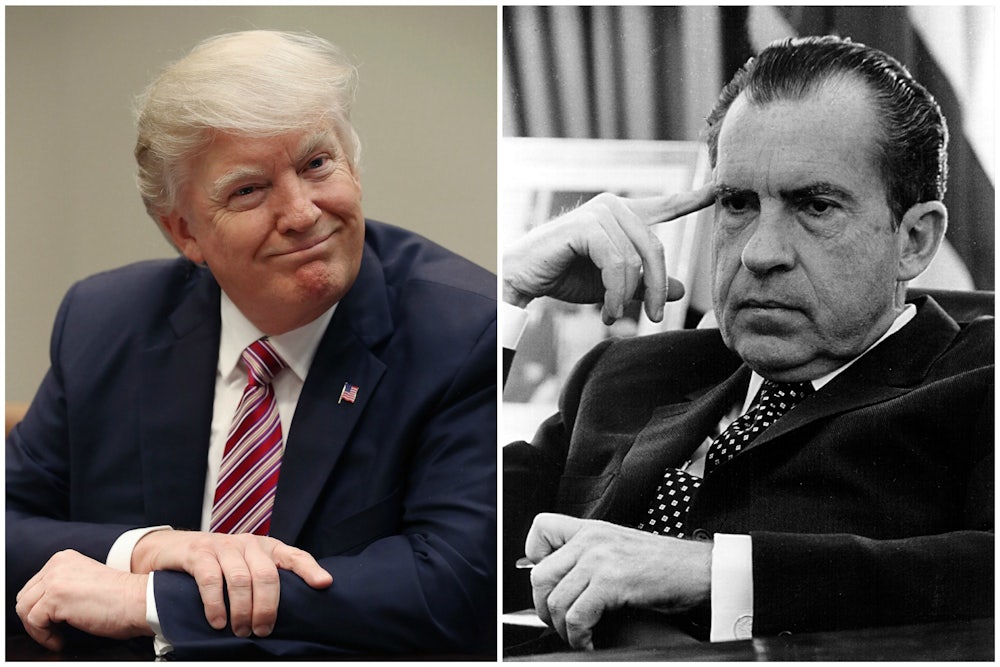Jared Kushner, reportedly the new power behind the throne in the Trump administration, has tried to borrow luster from another presidential éminence grise, Henry Kissinger. Kushner introduced himself to Kissinger after a foreign policy lecture in 2015, and since then has kept in touch with the former secretary of state. We know this because Kissinger wrote an exceptionally lukewarm tribute to Kushner for Time magazine’s 100 Most Influential People issue, which he concluded by comparing Kushner to the mythical Icarus, a nepotism hire who crashed and burned after flying too close to the sun.
Whatever Kissinger’s private reservations about Kushner, there are some parallels to be drawn between the Nixon and Trump administrations, especially in their bureaucratic intrigue and the cultivation of an image of unpredictability (what Nixon called the “madman theory”). But Trump isn’t so much a modern Nixon as a clown Nixon, repeating the tragedy of the 37th president’s flawed policies without having the Nixonian intelligence or competence to know what he’s doing.
Nixon and Kissinger came to Washington intending to start a foreign policy revolution, one that would rescue America from its increasing isolation with a dual program of detente with the Soviet Union and opening up to China. But to carry out this revolution, they had to work around the permanent government housed in the State Department and the Pentagon. As University of Kentucky historian George Herring noted in his 2008 book From Colony to Superpower, Nixon and Kissinger were “reluctant to share power and certain that a hidebound bureaucracy could be an obstacle to the bold moves they hoped to implement,” so they put foreign policy in the hands of Kissinger as head of the National Security Council, shutting out diplomats and military men. The Byzantine intrigue got so intense that Defense Secretary Melvin Laird and Thomas Moorer, chair man of the Joint Chiefs of Staff, began spying on the president and Kissinger. As Herring recounts, the JCS “employed a navy yeoman to purloin documents to keep them informed about what was going on in the White House.” (Nixon, meanwhile, wiretapped Laird’s chief aide.)
A similar dynamic is at work in the Trump administration with the so-called axis of adults—Secretary of Defense James Mattis, Secretary of State Rex Tillerson and Homeland Secretary John Kelly, often working with NSC adviser H.R. McMaster—which is pushing for a more traditional hawkish foreign policy, against Trump’s desire for a unilateralist America First revolution. But Trump and his immediate coterie are much less adept at bureaucratic infighting than Nixon and Kissinger were. Trump himself is singularly lazy, unfocused, and ignorant of how the government functions. As a result, while Nixon and Kissinger carried out a foreign policy revolution, Trump’s foreign policy has been characterized by incoherence.
That reality has not prevented certain journalists from hailing the victory of the “adults” over the America First brigade. But in fact, there has been no clear-cut victory, as this battle has led to missteps and mixed signals. As The Washington Post notes, “President Trump’s efforts to appear decisive and unequivocal in his responses to fast-moving global crises have been undercut by confusing and conflicting messages from within his administration.” The administration has made contrary statements on Syrian policy (whether removing dictator Bashar al-Assad is a priority), Turkish policy (the State Department criticized President Recep Tayyip Erdogan’s power grab, but the president congratulated him) and Korean policy (Vice President Mike Pence took a much harder line than McMaster).
As Georgetown professor Daniel Nexon and graduate student Dani Nedal observed this week in Foreign Policy:
Some commentators link Trump’s championing of unpredictability to the so-called “madman theory” of Richard Nixon’s attempt to persuade rivals — including the North Vietnamese and the Soviet Union — that he was impulsive and unpredictable. Neither Hanoi nor Moscow was ever entirely convinced by Nixon’s stance. But the madman theory also wasn’t about Trumpian unpredictability. Nixon wanted to convince his adversaries that he was irrational, but consistent, when it came to calculating the downsides of using force.
In Nixon’s own words, as recorded by aide H.R. Haldeman, the “madman theory” was about convincing adversaries that Nixon had a clear agenda and no limits on what he would do to achieve it. “I want the North Vietnamese to believe I’ve reached the point where I might do anything to stop the war,” Nixon told Haldeman on a late night walk on the beach. “We’ll just slip the word to them that, for God’s sake, you know Nixon is obsessed about Communism. We can’t restrain him when he’s angry—and he has his hand on the nuclear button—and Ho Chi Minh himself will be in Paris in two days begging for peace.”
For Nixon, being a madman meant having a singleminded focus and no restraint on tactics. Trump’s version of the madman theory is quite the opposite: being unpredictable because he can’t control the various factions in your government and has a flighty temperament.
Nixon was a flawed figure, while Trump is a farcical one. Trump is less a twenty-first century Nixon than his absurd doppelgänger. Despite his warped personality, Nixon made some substantial, positive, and lasting changes in American foreign policy. So far, Trump is only sowing confusion and disorder. But there is one area where Nixon and Trump really are similar: As American presidents, both held the power of life and death over the world.
